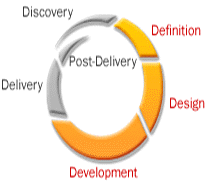| Lesson 4 | The process |
| Objective | Describe the process for designing signs and metaphors. |
Signs Metaphors Design Process
Describe Process for Designing Signs and Metaphors
Many of the existing website evaluation methods and criteria for evaluating website quality are not able to sufficiently assess the performance and quality of a website, and most of them focus on usability and accessibility. Website quality metrics and methods should be used to measure the website interface and reputation quality factors. The evaluation metrics have a framework which can be viewed as a hierarchical tree with three levels.
The first level is composed of five quality characteristics: Aesthetics, Ease of Use, Multimedia, Rich Content and Reputation. The second level breaks down the first level quality characteristics into sub-characteristics and the third level further breaks down the second level sub-characteristics into measurable criteria. This thesis is particularly concerned with two major quality characteristics:
The first level is composed of five quality characteristics: Aesthetics, Ease of Use, Multimedia, Rich Content and Reputation. The second level breaks down the first level quality characteristics into sub-characteristics and the third level further breaks down the second level sub-characteristics into measurable criteria. This thesis is particularly concerned with two major quality characteristics:
- Aesthetics and
- Reputation,
Use a website evaluation tool to measure website quality automatically. The evaluation tool should include a traversal unit, parsing unit, data metrics unit and user interface unit.
Also some effective algorithms should be used in each unit:
To completely measure the website metrics, and highlight the entire website quality scores that meet the requirements of users.
- data crawler,
- recursive,
- parser and data transmission.
To completely measure the website metrics, and highlight the entire website quality scores that meet the requirements of users.
A great number of new websites are launched every day. Websites with similar content will not have the same degree of quality. If the quality is poor, the user will simply leave the website and go elsewhere. Generally, there is no second chance to get a user back to the website. The quality of a website makes a website profitable, user friendly and accessible. In addition, it also offers useful and reliable information, providing good design and visual appearance to meet the needs of the users.
Website quality is dependent on the quality of the software. In the early years, the quality of software provided effective support to develop the performance of the websites. The quality assurance process became the challenge for the new discipline of website application.
There were a number of experts who researched different proposals to improve website quality, including quality frameworks, criteria, evaluation methodologies, approaches and metrics. The website quality process has become a particularly valuable topic which is ongoing. A set of metrics has been proposed for quantifying website quality attributes since the 1990s. Although the quality of websites have been gradually improving in recent years, a big question is "Why is the quality of websites still poor?"
Website quality is dependent on the quality of the software. In the early years, the quality of software provided effective support to develop the performance of the websites. The quality assurance process became the challenge for the new discipline of website application.
There were a number of experts who researched different proposals to improve website quality, including quality frameworks, criteria, evaluation methodologies, approaches and metrics. The website quality process has become a particularly valuable topic which is ongoing. A set of metrics has been proposed for quantifying website quality attributes since the 1990s. Although the quality of websites have been gradually improving in recent years, a big question is "Why is the quality of websites still poor?"
Work flow
We have stated that there are three general stages of work for the implementation of signs and metaphors: determine needs, create, and evaluate.
You are also familiar with the Web Site Development Process Model, which breaks the process down into six distinct phases.
To see the relationship between these three general stages relating to signs and metaphors, and the six phases of the process model, roll your mouse over each of the three stages.

Three Stages Signs Metaphors
In the next lesson, you will learn how the Request for Proposal (RFP) is used to integrate a client's business objectives into a Web design project.
In the next lesson, you will learn how the Request for Proposal (RFP) is used to integrate a client's business objectives into a Web design project.